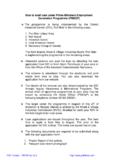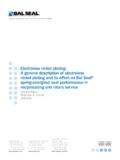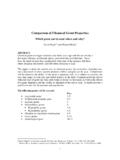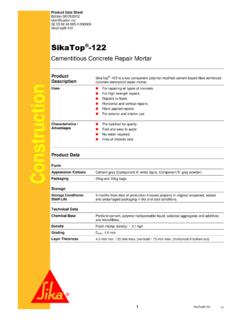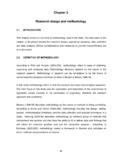Transcription of SYLLABUS FOR NCVT TRAINING COURSES …
1 SYLLABUS FOR NCVT TRAINING COURSES CONDUCTED BY DIRECTORATE OF INDUSTRIES Name : Basic Wood Work Sector : Wooden Furniture Code : W00101 Entry Qualification & Age : Vth Standard, 14 years & Above During : 270 hours Terminal Competency : The participant will be able to:- Identity, select, use and store tools, equipments and materials used in Carpentry in a safe manner Carry out Sawing and planning Make joints and simple products course Contents:- Practical Competencies Underpinning Knowledge (Theory) Identification of tools an equipments used in carpentry & shuttering Use of protective clothing, boots, goggles and equipment as applicable to a task.
2 Good house keeping practices, proper handling of materials and waste disposal. Safety precautions and safety belts while working at site. Store/ lay materials at work in safe manner. Use and store of tools and equipments in a safe manner. Measurement length, width & depth in MKS & FPS system. Role of Carpenter Description of trade. Different types of tools and equipments used in Carpentry. Safety precautions. While using different hand tools. While using raw materials. With co-workers. Knowledge of measurement and its conversion to other system. Size a raw timber using proper tools to measure. Mark, cut and drill holes within required tolerances and standards. Preparation of play piece out of plywood sheet using proper tools to measure, mark, cut and drill holes within required tolerance and standards.
3 Preparation of half lap, dove tail, tenon & mortise joints with shaped timbers using proper tools to measure, mark, cut and fit within required tolerances and standards. Produce simple products stool and box. Identification of timber as per quality and classification, care and safe uses of tools. Understanding tolerances & house keeping. Identification of plywood as per quality, use and classification, care and safe uses of tools. Understanding tolerances. Storage & maintenance of plywood. Identification, care and safe uses of timber jointing tools, knowledge of various joints and appropriate applications, their relative merits and demerits. -2- Wooden Furniture Making Name : Wooden Furniture Making Sector : Wooden Furniture Code : W00202 Entry Qualification & Age : Vth Standard, 14 years and above MES module on Basic Wood Work Duration : 270 hours Terminal Competency Identity, select, use and store tools, equipments and materials use in wooden furniture making in a safe manner.
4 Make stool, Divan, Dining table, Chair, Single and double beds, Dressing table. CONTENTS: Practical Competencies Underpinning Knowledge(Theory) Use of protective clothing and boots Identity, tool, equipments and materials Used in wooden furniture making. Apply good house keeping practices, proper handling of materials and disposal of waste, follow statutory regulations. Safety precautions, use of protective clothing and elementary first aid. Functions and uses of various tools tools and equipment. Reasons for carrying out good housekeeping practices. Care and use of tool, equipment and materials used in fitting. 3- Practical Competencies Underpinning Knowledge(Theory) Carry out basic first aid treatment/ notifying accident.
5 Store/lay materials at work in safe manner. Select proper tools and equipments in a safe manner. Select proper tools for a particular Task. Take measurements using appropriate measuring tools. (Measuring tools: measuring taps, Steel rule) Read and interpret simple blue prints and drawings. Draw freehand sketches of furniture to explain to the customers. (Furniture: Stools, Divan, Dinning tables, Chairs, Single and double beds, Dressing table) Estimate the type and quantity of materials required for each job. (Job: Stools, Divan, Dinning tables, Chairs, Single and double beds, Dressing table) Estimate the types and quantity of materials required for each job. (Job: Stools, Divan, Dinning tables, Chairs, Single and double beds, Dressing tables) Select the correct type of timber/ ply etc.
6 For a given job. Measure, mark and cut the timber according to the required dimensions. Selection and correct use of tools Criteria for selection of tool for different operations. Proper handling and correct use of hand tools. Types of measuring tools. Least count and errors. Measurements procedures. Safety precautions related to measuring tools. Introduction of marking tools. Application of marking tools. Safety, proper handling and use of marking tools.. Introduction to sheet metal hand tools and machine tools and safety precautions to be observed while using them. Types of sheet metal and their Applications. Different sizes of Sheet metal commercially available. -4- Practical Competencies Underpinning Knowledge(Theory) Make templates for different operations.
7 Plane the work pieces to accuracy. Make appropriate joints for stability and strength. Select the adhesives to fix ply, Sunmica etc., apply adhesive and fix sunmica etc. Fix molding beats, wherever required. (Molding beets: Wooden beats, Aluminum beats, beats) Fix general accessories, if required. (Accessories: Rubber shoes, Wheels Handles, Decorative pieces, Handles) Fix glasses and mirrors according to Customer requirements. List out the materials required for the given product. Estimate cost of materials required. Estimate man power and time required for completing the work. Estimate labour cost, overheads and cost of utilities (Power, water). Estimate the total cost involved in production of a product. Metal joining method. Types of seams and allowances. Types of rivets and their applications.
8 Types of rivet joints. Defects of riveted joint. Safety precautions. Knowledge of limits, fits, tolerance Systematic steps of different operations. Safety consideration in each operation. -5- Module-2 1. Name of the Module : BASIC WELDING (Arc) 2. Sector : FEBRICATION 3. Code : FAB102 4. Entry Qualification : Minimum 8th Std. and 14 years above 5. Terminal Competency : After completion of this TRAINING , the participants would be able to a). join metals by arc welding process b).
9 Repair components/parts used in household & industrial appliances. 6. Duration : 120 Hrs. 7. Contents. Practical Competencies Underpinning Knowledge (Theory) Use of protective safety devices on Shop floor. Safe working practice to be Observed during welding. Identification of tools and accessories used for Gas welding. Setting up Arc Welding plant Striking an arc and depositing Straight and wearing beads on MS in Flat position. Preparation of joints, edge operation. a). Fillet Lap & T joints b). Inside corner joint c).
10 Square butt joint d). Single V but joint Identification of defects by Visual inspection & correction of defects. Reading of fabrication drawing. Introduction to welding. Safety precautions. Types of welding processes and application. Nomenclature of Fillet and groove Welds. Welding terms and definitions. Principles of Manual Metal Arc Welding (MMAW). Advantages and limitations. Basic Electricity applicable to welding. Arc welding power source, AC Transformer, DC welding rectifier, DC generators. Types of welding joints and edge preparation. Welding electrodes and selection. Coding of MMAW electrodes. Arc welding procedure and technique. Welding defects causes and remedy. Distortion and methods of control. Welding symbols. -6- Module - 1 1. Name of the Module : BASIC WELDING (GAS) 2.

